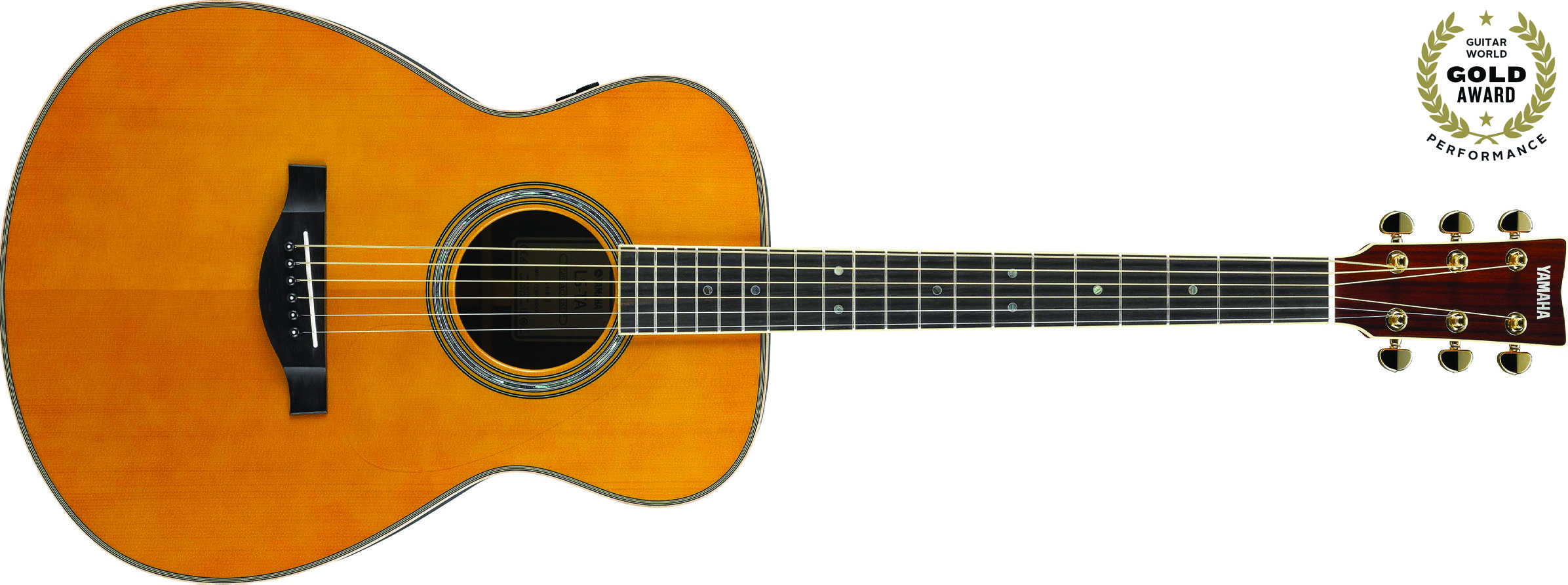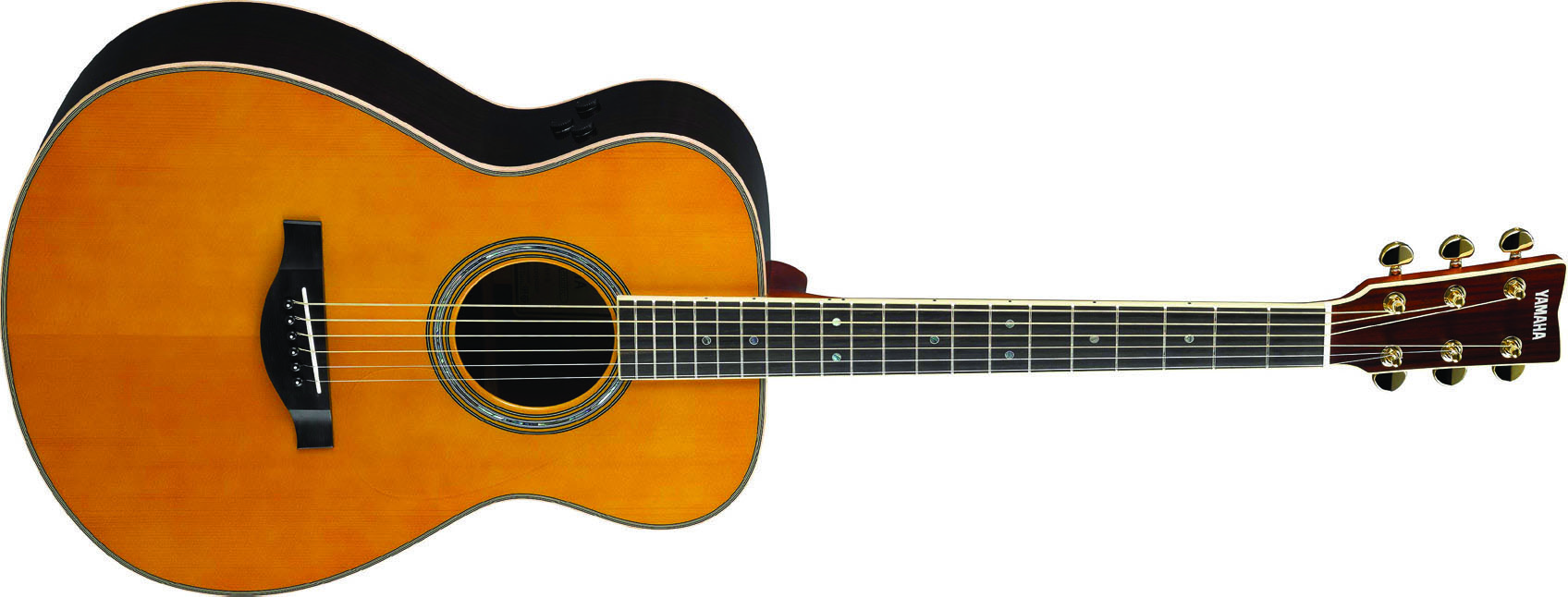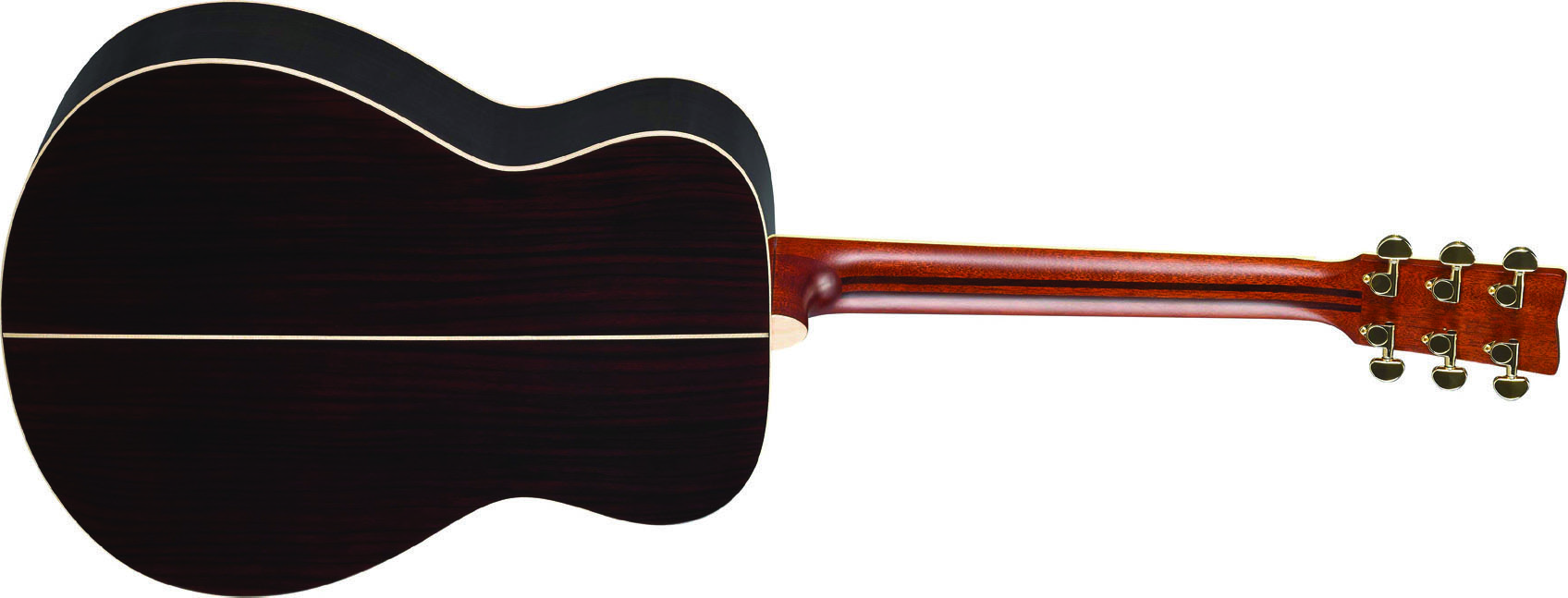Review: Yamaha TransAcoustic LS-TA Guitar

Playing an unplugged acoustic guitar is one of life’s greatest simple, uncomplicated joys. But sometimes a guitarist wants just a little more than the raw, naked sound of the acoustic strings resonating in the guitar’s body, such as some reverb or chorus to add depth and dimension to the overall sound. One could always plug into an acoustic guitar amp or use an app and some headphones, but the extra equipment and cables tend to distract from that freewheeling feeling of just picking up a guitar and playing.
Yamaha’s new TransAcoustic technology allows acoustic guitar players to enjoy effects-processed sounds directly from the guitar’s sound chamber without any external boxes, devices or equipment and without changing the overall aesthetics of an acoustic-electric guitar. The effects even work when the guitar is plugged into an amp or mixing board, providing even greater convenience for performing players. Yamaha offers four TransAcoustic models with the technology built into their already popular and acclaimed L and FG series designs, so anyone interested in this technology can rest assured that the guitar itself meets high quality standards. We took a look at the LS-TA model.
FEATURES
First and foremost, the LS-TA is a fine-crafted concert-size flattop steel-string acoustic comparable to the Yamaha LS16 ARE with a solid Engelmann spruce top, solid rosewood back and sides, five-piece mahogany and rosewood neck and ebony fingerboard and bridge. The gold-plated Yamaha die-cast tuners, shell dot neck inlays and rosette ring, clear teardrop-shape pickguard and maple binding with multiply black and white purfling surrounding the top combine to give the guitar a deluxe touch of class. Neck features include a 25 9/16-inch scale, 1 ¾-inch nut width, 15 ¾-inch radius, 20 medium frets and a comfortable, shallow C-shape profile. The top has received Yamaha’s proprietary A.R.E. (Acoustic Resonance Enhancement) treatment that gives new wood the characteristics of aged, vintage wood.
On its own, the guitar is impressive, but the built-in TransAcoustic technology offers an even more compelling reason to check it out. Located on the upper bass bout are three control knobs that turn the TransAcoustic feature on or off, adjust the level of a room or hall reverb effect, adjust the level of a chorus effect, and adjust the level of the line output when the guitar is plugged into an external amplification system. Note, however, that no external amplification is needed to hear the reverb and chorus effects, which instead are amplified internally by the guitar’s natural resonance chamber.


The TransAcoustic technology achieves this via an actuator mounted inside the resonance chamber on the guitar’s back that senses string vibrations, amplifies and processes them, and transfers the processed sound via the guitar’s natural vibrations. It’s sort of like a transducer in reverse—instead of picking up vibrations from the guitar’s body the actuator transfers vibrations to the body. The reverb and chorus effects are also amplified through the guitar’s piezo saddle pickup when the guitar is plugged into an external amp.
PERFORMANCE
On its own, the LS-TA delivers outstanding, rich, complex acoustic tone and provides exceptionally comfortable playability. The TransAcoustic feature is a huge bonus, however, as one still enjoys the exact same sensation of playing an unplugged acoustic guitar but with the benefit of rich reverbs and lush chorus that adds an element of professional polish. Best of all, the sound is remarkably organic and natural, with the reverbs producing smooth tails and the chorus adding 12-string-like shimmer and depth. The TransAcoustic concept makes great sense—an acoustic guitar’s body is already essentially a speaker cabinet, so why not employ it in that manner?
The design is very well thought out as well. The system is powered by a pair of AA batteries that mount unobtrusively in a compartment below the endpin jack. The reverb effect automatically switches from room to hall at the corresponding control knob’s halfway point, and there’s a subtle effect dropout at dead center to let users know where the change crosses over (the dropout is more obvious when the guitar is plugged in). My only quibble is that it can sometimes be difficult to tell when the TransAcoustic feature is turned off, especially after one has become used to it and it seemingly melds with the guitar’s natural acoustic tone. An LED or even a momentary indicator of some sort would be helpful to avoid prematurely wearing out the batteries.
Get The Pick Newsletter
All the latest guitar news, interviews, lessons, reviews, deals and more, direct to your inbox!
LIST PRICE: $1,600
MANUFACTURER: Yamaha Musical Instruments, usa.yamaha.com
- High-quality materials include an A.R.E.-treated solid Engelmann spruce top, solid rosewood back and sides, five-piece mahogany and rosewood neck and ebony fingerboard and bridge.
- Knobs mounted on the upper bass bout control TransAcoustic on/off and line out, room/hall reverb and chorus levels.
- A built-in actuator instantly processes the strings’ vibrations, processes them and transfers vibrations naturally to the body to produce reverb and chorus acoustically within the sound chamber.
- The reverb and chorus effects also can be amplified externally via the guitar’s built-in under-saddle piezo pickup system.
THE BOTTOM LINE
Whether playing at home or for small crowds on the streets, the Yamaha LS-TA with its revolutionary TransAcoustic technology allows acoustic guitarists to enjoy pro-quality effects without sacrificing the freedom of playing unplugged.
Chris is the co-author of Eruption - Conversations with Eddie Van Halen. He is a 40-year music industry veteran who started at Boardwalk Entertainment (Joan Jett, Night Ranger) and Roland US before becoming a guitar journalist in 1991. He has interviewed more than 600 artists, written more than 1,400 product reviews and contributed to Jeff Beck’s Beck 01: Hot Rods and Rock & Roll and Eric Clapton’s Six String Stories.
“While the odd corner has clearly been cut, these are true Gibsons with all the individuality that this brand exhibits”: Gibson J-45 Special and Hummingbird Special review
“Fender has stripped back the price – but has it gone too far paring back the sounds, too?” Fender Standard Acoustasonic Telecaster review










